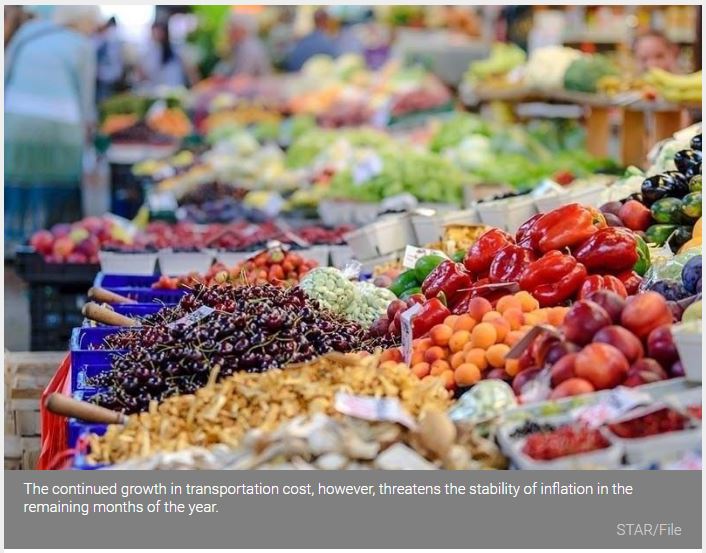Philippines: Inflation up in October but not for good reasons
MANILA, Philippines (UPDATE 10:29 a.m., Nov. 5)— Tight pork supplies and rising tuition that came with schools restarting classes fueled inflation to hit a 3-month high in October, a kind of price pick-up that hardly reflected consumption finally getting its groove back from the damage caused by pandemic-induced lockdowns.
Prices of basic goods and commodities, as measured by the consumer price index, accelerated 2.5% year-on-year last month from 2.3% in the previous month, the Philippine Statistics Authority reported on Friday. The result fell comfortably within the central bank’s 1.9-2.7% forecast for the month.
In a briefing, National Statistician Claire Dennis Mapa said higher food prices and tuition costs pushed up inflation last month. For the former, pork prices accelerated as supplies tightened in Metro Manila and neighboring provinces. The latter came with public schools restarting classes last month.
That inflation has gained pace anew, however, appeared not because of higher demand. Price increases had tapered off since lockdowns were enforced in March as consumers that typically fuel price adjustments with their hefty purchases stayed home and held back from spending. The Bangko Sentral ng Pilipinas (BSP) expects that to persist until the end of the year.
“The October 2020 inflation of 2.5% is consistent with the BSP’s prevailing assessment of favorable inflation dynamics over the policy horizon,” BSP Governor Benjamin Diokno said in a statement after the data was released. Year-to-date, inflation averaged 2.5%, well within the BSP’s 2-4% target for the year.
“The balance of risks continues to be on the downside due largely to the impact of domestic and global economic activity of possible deeper economic disruptions caused by the coronavirus pandemic,” he added.
Sanjay Mathur, chief economist at ANZ Bank, said inflation is not gaining ground for good reasons. “I would not attribute the higher than anticipated inflation data to the opening up of the economy. It is higher food prices that have made the bulk of the contribution which technically should have reduced logistics costs in an economy that is opening up,” Mathur said in an e-mail.
Nicholas Antonio Mapa, senior economist at ING Bank in Manila, agreed. “The pickup in prices was more likely due to cost push factors with African Swine fever forcing pork prices higher while social distancing protocols making transport prices and educational costs rise,” Mapa said in a separate e-mail.
Swine flu impact
Food prices, which accounted for 29% of the basket of goods and services used to measure inflation, ticked up 2.5% year-on-year in October from 2.3%. In this segment, pork prices accelerated 4.7% year-on-year in October from just 2.9% in previous month due to pork sickness that crippled supplies in Metro Manila and neighboring areas.
To demonstrate how is that affecting retail rates, National Statistician Claire Dennis Mapa, not related to ING’s Mapa, said meat with bones now cost an average of P262 per kilo in Metro Manila from just P202 the month before.
Fish prices also rose 3.7% from 2.6% year-on-year, while a decline in vegetable costs tempered to 0.5% from 2.7% in similar period. This is only bound to worsen as the impact of typhoons Quinta and Rolly, which battered Luzon late last month, is felt on prices for November.
“Our (inflation) readings are conducted first week and middle of the month…Definitely, we will see some price changes this month because of the typhoons,” PSA’s Mapa said in Filipino.
Tuition up
Higher tuition was also a factor. The education index slightly reflected faster inflation at 1.2% year-on-year in October. But breaking down the figure, college tuition rose a faster 1.5% annually, while that from high school gained 1.3% just as when public schools began classes this school year last month.
Meanwhile, as people had finally adjusted to months of reopening from coronavirus restrictions, the increase in transport costs eased to 7.9% year-on-year from 8.3% in September. Tricycle fares remained the biggest driver of this, up 45.8% year-on-year, followed by jeepney and bus fares at 6.4% and 4.1% respectively.
Data showed consumer prices picking up was partly because of higher prices for restaurant and miscellaneous goods services which appeared to indicate businesses opening up and demand picking up. In particular, costs of barbershop services rose 7.6% on-year from 7% in previous month.
“We’ve seen this in previous months, barbershop increasing prices because of additional costs from PPEs (personal protective equipment) they use. This is particularly evident when the economy reopened,” Mapa said in an online briefing.
By location, inflation in Metro Manila and outside of that region both hastened to 2.5% year-on-year. Mapa, however, does not expect consumer demand to gain pace even with the holidays just around the corner.
“We do not expect demand pull factors to surface anytime soon with the economy mired in a recession,” he said.
Source: https://www.philstar.com/business/2020/11/05/2054756/inflation-october-not-good-reasons


 Thailand
Thailand




